【DES】详解

DES 算法总览
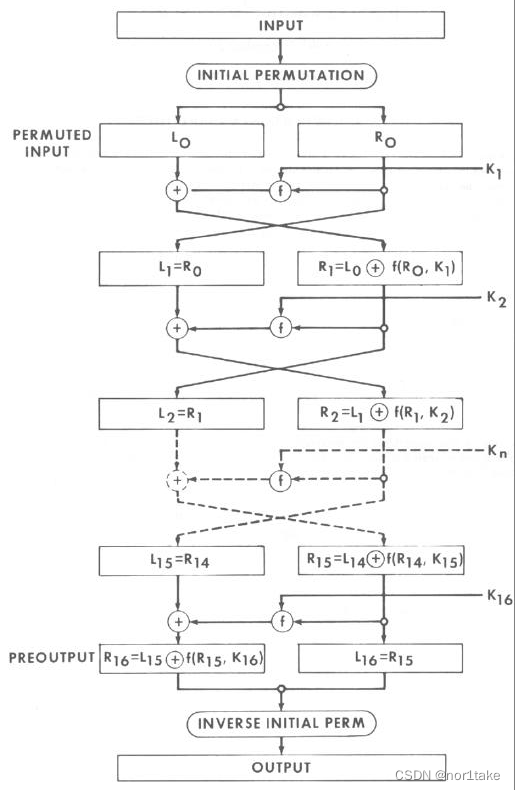
0-1、初识置换 IP(Initial Permutation)
输入:明文(64 bits)
过程:初识置换
输出:处理后的明文permuted input(64 bits)
首先,对需要解密的input block(64 bits)进行如下置换*,称之为 初识置换(Initial Permutation, IP)。
置换(Permutation)是古典密码中另一种基本的处理技巧,就是将明文中的字母重新排列,字母本身不变,只是改变其位置。
//Operation.java
public int[][] ip = new int[][]{{58, 50, 42, 34, 26, 18, 10, 2},{60, 52, 44, 36, 28, 20, 12, 4},{62, 54, 46, 38, 30, 22, 14, 6},{64, 56, 48, 40, 32, 24, 16, 8},{57, 49, 41, 33, 25, 17, 9, 1},{59, 51, 43, 35, 27, 19, 11, 3},{61, 53, 45, 37, 29, 21, 13, 5},{63, 55, 47, 39, 31, 23, 15, 7}
};
如何根据表,进行置换操作?
第1行第1列的数 = 58 表示 将明文中的第58位的数放到第1位;
第1行第2列的数 = 50 表示 将明文中的第50位的数放在第2位;
…
数组中,第i行第j列的数 = m 表示 将明文中的第m-1位的数放到第(i*总列数+j)位(此处i,j都是0-index,但是m是1-index,为了对应到数组,使用m-1)。
//Unit.java
String handled_text = init_permutation(plain_text);
//Unit.java
private String init_permutation(String plain_text) {return op.permutation(plain_text, op.ip);
}
//Operation.java
public String permutation(String text, int[][] grid) {char[] tmpCharArray = text.toCharArray();int leni = grid.length;int lenj = grid[0].length;char[] resCharArray = new char[leni * lenj];for (int i = 0; i < leni; i++) {for (int j = 0; j < lenj; j++) {int index1 = i * lenj + j;int index2 = grid[i][j] - 1;resCharArray[index1] = tmpCharArray[index2];}}return new String(resCharArray);
}
Unit类包含对一个unit,即input block(64 bits)进行处理。Operation类包含置换数组ip、置换操作permutation等基本数据和操作。
显然,op是Operation的一个实例化对象。
0-2、16个子密钥(Ki)的生成
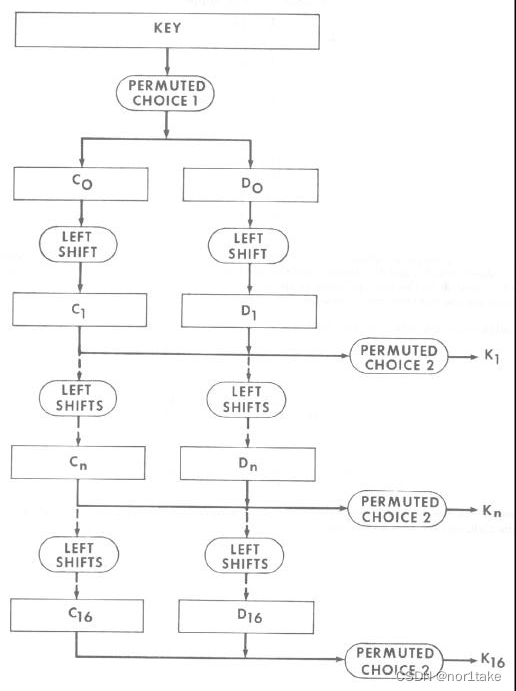
输入:密钥(64 bits)
过程1:Permuted Choices 1(依然是一个置换操作)
中间量:处理后的密钥1(56 bits)
过程2:对 处理后的密钥均分出来的C0、D0(28 bits)进行左移(注:每轮左移位数不同)
中间量:处理后的密钥2(56 bits) = C0’ + D0’
过程3:Permuted Choices 2(置换操作)
输出:子密钥1(48 bits)
//Operation.java
public int[][] pc1 = new int[][]{{57, 49, 41, 33, 25, 17, 9},{1, 58, 50, 42, 34, 26, 18},{10, 2, 59, 51, 43, 35, 27},{19, 11, 3, 60, 52, 44, 36},{63, 55, 47, 39, 31, 23, 15},{7, 62, 54, 46, 38, 30, 22},{14, 6, 61, 53, 45, 37, 29},{21, 13, 5, 28, 20, 12, 4}
};public int[][] pc2 = new int[][]{{14, 17, 11, 24, 1, 5},{3, 28, 15, 6, 21, 10},{23, 19, 12, 4, 26, 8},{16, 7, 27, 20, 13, 2},{41, 52, 31, 37, 47, 55},{30, 40, 51, 45, 33, 48},{44, 49, 39, 56, 34, 53},{46, 42, 50, 36, 29, 32}
};public int[] left_shift = new int[]{1, 1, 2, 2, 2, 2, 2, 2, 1, 2, 2, 2, 2, 2, 2, 1};
置换操作为什么可以减少bit?
从数组PC-1(Permuted Choices 1)可以看出:数组中并没有8、16、…、64,说明:在生成output的时候,并没有选择input的第8位、第16位、…、第64位,自然就能做到减少bit。之后的拓展置换同理。
KEY的每8位中的1位用于密钥生成、分发和存储中的错误检测。第8,16,…,64位用于每个字节奇偶校验。
//Unit.java
subKey_generation();
//Unit.java
private void subKey_generation() {//1、PC-1 K(64) -> K'(56)String handled_secret_key = op.permutation(secret_key, op.pc1);//2、K'/2 = C, D(28)op.cut(handled_secret_key);String C = op.tmpL;String D = op.tmpR;int epoch = 0;while (epoch < 16) {//C, D左移for (int i = 0; i < op.left_shift[epoch]; i++) {C = op.shiftLeft(C);D = op.shiftLeft(D);}//PC-2 C+D(56) -> subKeys[i](48)subKeys[epoch] = op.permutation(C + D, op.pc2);epoch++;}
}
//Unit.java
//平分字符串(存入全局变量tmpL tmpR)
public void cut(String text) {int len = text.length();tmpL = text.substring(0, len / 2);tmpR = text.substring(len / 2);
}
//Unit.java
//不做“正负数左移补1还是0”的讨论,统一为:补第1位(即:第1位是0补0,第1位是1补1)
public String shiftLeft(String text) {return text.substring(1) + text.charAt(0);
}
1、加密过程(16轮)
现在,我们已经准备好:处理(Initial Permutation)后的明文 和 子密钥 Ki。
在第一轮加密中,处理后明文的右半部分R0和子密钥进行了一个f操作,得到f(R0, K1),f(R0, K1)和L0异或得到下一轮的R1,即如图公式:R1 = L0 XOR f(R0, K1)。而新一轮的L1就是上一轮的R0。
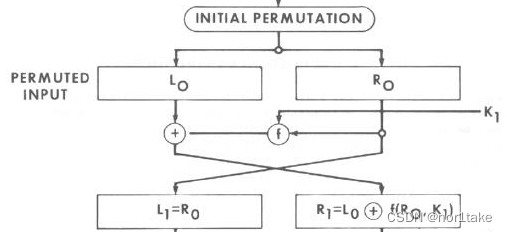
后面的每一轮都是重复上述过程:

操作f的具体步骤:
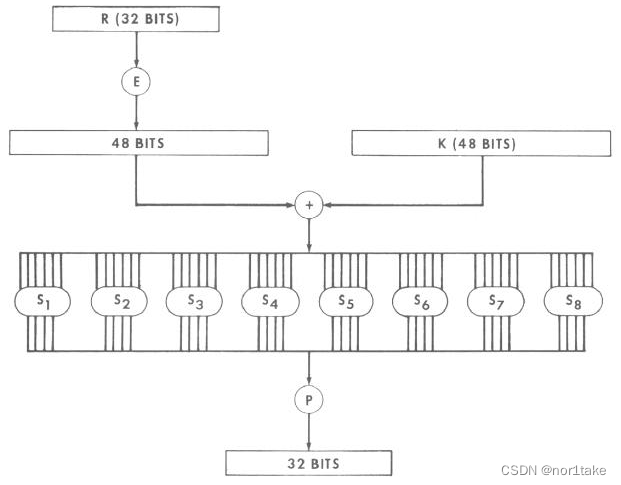
输入:每轮处理后的明文的右边部分R(32 bits)
过程1:E(拓展置换)
中间量:R’(48 bits)+ 当前轮的子密钥 Ki(48 bits)
过程2:异或
中间量:M(48 bits)
过程3:S盒(input:M每6 bits对应一个Si操作;output:4 bits)
中间量:M’(32 bits)
过程4:P(置换)
输出:M’'(32 bits)
操作Si的具体步骤:
input(6 bits)的首尾 bit 构成一个二进制数,表示 行i;input(6 bits)的中间 4 bits 构成一个二进制数,表示 列j- 在数组
Si中,找到Si[i][j],并将其转化成 4 bits的二进制输出output
//Operation.java
//E置换
public int[][] extend = new int[][]{{32, 1, 2, 3, 4, 5},{4, 5, 6, 7, 8, 9},{8, 9, 10, 11, 12, 13},{12, 13, 14, 15, 16, 17},{16, 17, 18, 19, 20, 21},{20, 21, 22, 23, 24, 25},{24, 25, 26, 27, 28, 29},{28, 29, 30, 31, 32, 1}
};
//P置换
public int[][] p = new int[][]{{16, 7, 20, 21, 29, 12, 28, 17,},{1, 15, 23, 26, 5, 18, 31, 10,},{2, 8, 24, 14, 32, 27, 3, 9,},{19, 13, 30, 6, 22, 11, 4, 25},
};//Si
public int[][] S1 = new int[][]{{14, 4, 13, 1, 2, 15, 11, 8, 3, 10, 6, 12, 5, 9, 0, 7},{0, 15, 7, 4, 14, 2, 13, 1, 10, 6, 12, 11, 9, 5, 3, 8},{4, 1, 14, 8, 13, 6, 2, 11, 15, 12, 9, 7, 3, 10, 5, 0},{15, 12, 8, 2, 4, 9, 1, 7, 5, 11, 3, 14, 10, 0, 6, 13}
};
public int[][] S2 = new int[][]{{15, 1, 8, 14, 6, 11, 3, 4, 9, 7, 2, 13, 12, 0, 5, 10},{3, 13, 4, 7, 15, 2, 8, 14, 12, 0, 1, 10, 6, 9, 11, 5},{0, 14, 7, 11, 10, 4, 13, 1, 5, 8, 12, 6, 9, 3, 2, 15},{13, 8, 10, 1, 3, 15, 4, 2, 11, 6, 7, 12, 0, 5, 14, 9}
};
public int[][] S3 = new int[][]{{10, 0, 9, 14, 6, 3, 15, 5, 1, 13, 12, 7, 11, 4, 2, 8},{13, 7, 0, 9, 3, 4, 6, 10, 2, 8, 5, 14, 12, 11, 15, 1},{13, 6, 4, 9, 8, 15, 3, 0, 11, 1, 2, 12, 5, 10, 14, 7},{1, 10, 13, 0, 6, 9, 8, 7, 4, 15, 14, 3, 11, 5, 2, 12}
};
public int[][] S4 = new int[][]{{7, 13, 14, 3, 0, 6, 9, 10, 1, 2, 8, 5, 11, 12, 4, 15},{13, 8, 11, 5, 6, 15, 0, 3, 4, 7, 2, 12, 1, 10, 14, 9},{10, 6, 9, 0, 12, 11, 7, 13, 15, 1, 3, 14, 5, 2, 8, 4},{3, 15, 0, 6, 10, 1, 13, 8, 9, 4, 5, 11, 12, 7, 2, 14}
};
public int[][] S5 = new int[][]{{2, 12, 4, 1, 7, 10, 11, 6, 8, 5, 3, 15, 13, 0, 14, 9},{14, 11, 2, 12, 4, 7, 13, 1, 5, 0, 15, 10, 3, 9, 8, 6},{4, 2, 1, 11, 10, 13, 7, 8, 15, 9, 12, 5, 6, 3, 0, 14},{11, 8, 12, 7, 1, 14, 2, 13, 6, 15, 0, 9, 10, 4, 5, 3}
};
public int[][] S6 = new int[][]{{12, 1, 10, 15, 9, 2, 6, 8, 0, 13, 3, 4, 14, 7, 5, 11},{10, 15, 4, 2, 7, 12, 9, 5, 6, 1, 13, 14, 0, 11, 3, 8},{9, 14, 15, 5, 2, 8, 12, 3, 7, 0, 4, 10, 1, 13, 11, 6},{4, 3, 2, 12, 9, 5, 15, 10, 11, 14, 1, 7, 6, 0, 8, 13}
};
public int[][] S7 = new int[][]{{4, 11, 2, 14, 15, 0, 8, 13, 3, 12, 9, 7, 5, 10, 6, 1},{13, 0, 11, 7, 4, 9, 1, 10, 14, 3, 5, 12, 2, 15, 8, 6},{1, 4, 11, 13, 12, 3, 7, 14, 10, 15, 6, 8, 0, 5, 9, 2},{6, 11, 13, 8, 1, 4, 10, 7, 9, 5, 0, 15, 14, 2, 3, 12}
};
public int[][] S8 = new int[][]{{13, 2, 8, 4, 6, 15, 11, 1, 10, 9, 3, 14, 5, 0, 12, 7},{1, 15, 13, 8, 10, 3, 7, 4, 12, 5, 6, 11, 0, 14, 9, 2},{7, 11, 4, 1, 9, 12, 14, 2, 0, 6, 10, 13, 15, 3, 5, 8},{2, 1, 14, 7, 4, 10, 8, 13, 15, 12, 9, 0, 3, 5, 6, 11}
};
//Unit.java
for (int i = 0; i < 16; i++) {iteration(L, R, i);L = op.tmpL;R = op.tmpR;
}
//Unit.java
private void iteration(String L0, String R0, int i) {//L1 = R0op.tmpL = R0;//操作f(R0, Ki)//f1:E置换:R0(32) -> (48)R0 = op.permutation(R0, op.extend);//f2:(48) = R0 ^ subKey[0]String Rtmp = op.XOR(R0, subKeys[i]);//f3:S盒:(48) -> (32)String tmp = op.sBox_permutation(Rtmp);//f4:P置换:(32)->(32)tmp = op.permutation(tmp, op.p);//R1 = L0 XOR f(R0, Ki)String R1 = op.XOR(L0, tmp);op.tmpR = R1;
}
//Operation.java
public String sBox_permutation(String x) {char[] xArray = x.toCharArray(); // (48)int index = 0;StringBuffer res = new StringBuffer();// 8 轮,每轮处理 6 bits。输入: 6;输出: 4for (int i = 0; i < 8; i++, index += 6) {// row = 6 bits 的 首尾 bitint row = (xArray[index] - '0') * 2 + (xArray[index + 5] - '0');// col = 6 bits 的 中间 4 bitsint col = 0;for (int j = 1; j <= 4; j++) {col += (xArray[index + j] - '0') * Math.pow(2, 4 - j);}//在 Si 中定位一个整数int num = sBoxs.get(i)[row][col];res.append(binary[num]);}return res.toString();
}
2、最后一步
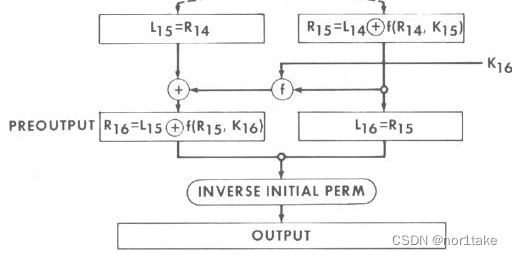
输入:
pre-output = R16 + L16(注:不是L16 + R16)
过程:inverse initial perm(逆初识置换)
输出:密文
//Operation.java
public int[][] anti_ip = new int[][]{{40, 8, 48, 16, 56, 24, 64, 32},{39, 7, 47, 15, 55, 23, 63, 31},{38, 6, 46, 14, 54, 22, 62, 30},{37, 5, 45, 13, 53, 21, 61, 29},{36, 4, 44, 12, 52, 20, 60, 28},{35, 3, 43, 11, 51, 19, 59, 27},{34, 2, 42, 10, 50, 18, 58, 26},{33, 1, 41, 9, 49, 17, 57, 25}
};
//Unit.java
cipher_text = anti_permutation(R + L);
//Unit.java
private String anti_permutation(String s) {return op.permutation(s, op.anti_ip);
}


